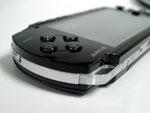 Firmware 2.0 is out for the PSP and it has a wide range of new functionality.
Firmware 2.0 is out for the PSP and it has a wide range of new functionality.
- A web browser has been added. It is fairly modern and supports CSS, HTTPS (secure browsing), JavaScript and graphics intensive web sites. It does not support Flash. GMail works but Ebay doesn’t.
- You can customise your PSP with themes and wallpapers
- WiFi networking now supports WPA (much better security than WEP).
- Atrac3+, WAV and MP4 (AAC) support (you may have to change the extension of your tracks to *.mp4)
- UMD video viewing enhancements (go-to, 4:3 mode and more)
- Support for more image formats (TIFF, GIF,PG, BMP)
To update: download the file from the Japanese site (translated press release). Transfer the file to your PSP and place the file in F:\PSP\GAME\UPDATE\EBOOT.PBP. Restart your PSP. It will detect the new firmware and proceed to update. Your media files (mp3s, photos, videos) will remain intact during the update process.
#PAGEBREAK#
The Japanese update even works on US PSPs. It is reported that the US 2.0 firmware will be identical, it is just being held of for “political” reasons. I guess this means that the UK PSP will be shipped with 2.0 and all this new functionality as well.
If you own an US PSP, then use the IGN version of the firmware instead (a few people have reported The game could not be started. (80020148) errors when using the Japanese firmware on their US PSP).
One possible drawback with the 2.0 firmware is that Sony has locked down all the loopholes that people were using to run unauthorised code. Home brewn code such as emulators (ScummVM), utilities and pirated games that worked on versions up to 1.5 will not work. It may however just be a matter of time before people exploit some buffer overflow in the new browser or other design flaws.
Now back to the garden and reading /. on the Sony Playstation Portable (PSP).
Update 25/08/05
Comments have been closed. Any more questions see the PSP forum!

 I have always thought of Japan as being the world capital for consumer electronics shopping; that there would be an amazing selection of gadgets at bargain prices to be found.
I have always thought of Japan as being the world capital for consumer electronics shopping; that there would be an amazing selection of gadgets at bargain prices to be found.